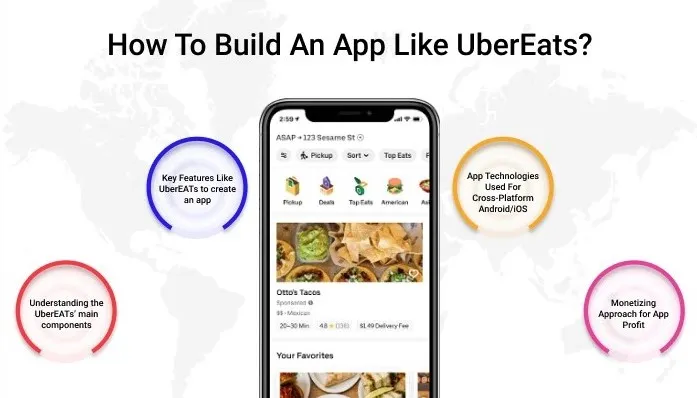Details, Fiction and See Full Details
Details, Fiction and See Full Details
Blog Article

The food service sector has experienced rapid expansion in the past few years, driven by growing demand for convenient on-demand services. With platforms such as Uber Eats and DoorDash revolutionizing the way consumers request meals, the emphasis has moved to creating cutting-edge food delivery apps. These apps offer customers the option to place orders from their favorite restaurants and have it delivered directly to their location. For companies, the challenge is to leverage technology to enhance delivery logistics and ensure a smooth customer experience.
Building the Perfect Food Delivery App
Creating a profitable food delivery app requires a deep insight of the market trends and operational strategies that lead the sector. Whether building a full-stack delivery solution or focusing on niche markets like virtual restaurants or cloud kitchens, the app’s features must to cater to both users and restaurants. Key features such as real-time order monitoring, delivery time optimization, and customer satisfaction metrics hold a critical role in ensuring customer loyalty.
Restaurant Delivery Partnerships: A Winning Strategy
Restaurants are increasingly establishing collaborations with delivery platforms to expand their market penetration. These partnerships assist restaurants provide to a larger audience while minimizing the obstacles of managing their own delivery services. The success of such alliances depends on technological synchronization, which boosts the app usability and improves the user satisfaction. Through these partnerships, restaurants can boost customer loyalty and make sure that they remain competitive in a saturated market.
How KPIs Drive Food Delivery Profitability
For any business, understanding its key performance indicators (KPIs) is crucial to maintaining profitability. In the food delivery industry, KPIs such as delivery time, order accuracy, and customer satisfaction are essential. Measuring and improving these KPIs enables delivery services to provide a better customer experience. Additionally, keeping an eye on financial success aids companies streamline operations, lower charges, and improve overall effectiveness.
Customer Satisfaction and User Retention Strategies
A significant factor in the success of delivery apps is their ability to keep customers through excellent customer service. Providing quick service and resolving user feedback quickly can help companies improve their service delivery. Moreover, implementing loyalty programs and offering incentives like free delivery can enhance user retention. User happiness can be further strengthened by maintaining quality assurance and providing a smooth processing system.
The Role of Technology in Food Delivery
Technology is at the core of modern food delivery services, enabling companies optimize their operations and deliver a seamless customer experience. From app creation to real-time order monitoring, tech integration plays a critical role in the success of delivery platforms. The application of data analytics to understand user profiles and preferences enables delivery services to provide personalized experiences, furthermore enhancing user engagement.
Competitive Analysis in the Food Delivery Market
The delivery sector is fiercely contested, with numerous players vying for market share. Conducting a market evaluation allows companies to gauge their standing in the market and spot opportunities for expansion. Delivery platforms must stand out by offering distinctive features such as ghost kitchen services, quick service, or specialized cuisine options. Analyzing market share and consumer behavior empowers companies to tailor their services and stay ahead of the rivals.
The Impact of the Pandemic on Food Delivery Services
The COVID-19 pandemic has had a profound impact on the delivery services, accelerating its growth as more people opted for on-demand apps due to social distancing measures. The shift has highlighted the importance of digital transformation in the culinary sector, with restaurants rapidly embracing online food ordering and delivery Loyalty Programs for Delivery Services apps. As the world adapts to new routines, delivery services must continue innovating to meet changing consumer demands and ensure business growth.
Investing in Food Delivery Startups
The food delivery industry presents plenty of entrepreneurial chances, with investors eager to support companies that provide innovative solutions. Efficient Food Delivery Logistics From creating UberEats clones to developing niche delivery apps, entrepreneurs have a range of paths to pursue. Investors seek out strong operation plans and the capacity to scale, particularly in areas like delivery network optimization, user experience (UX), and tech integration. By focusing on these sectors, startups can secure substantial investments and gain a foothold in the industry.
Enhancing Food Delivery Service Profitability and Expansion
Growing a food delivery business demands a strong base built on customer acquisition, cost models, and unique offerings. As regional platforms grow, businesses should focus on establishing a reliable delivery network and maintaining food safety. Furthermore, expanding the menu options, forming new collaborations, and integrating advanced tech solutions in food delivery will drive further expansion. By constantly enhancing delivery times and ensuring high customer satisfaction, companies can sustain a competitive edge and boost revenue generation.
These themes offer a comprehensive understanding of the food delivery ecosystem, with a emphasis on key aspects that propel the industry forward. Whether you’re a new company or an established business, focusing on these areas will help you thrive in the competitive world of food delivery.
Report this page